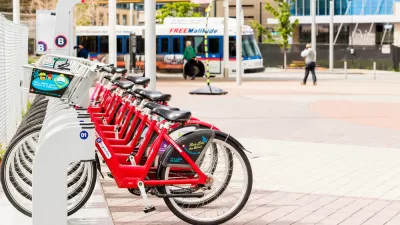A new study of the benefits of a bike lane project in Salt Lake City adds to the body of work suggesting that complete streets overhauls are a good investment for both the public and the private sectors.
"A growing body of evidence suggests that if bike lanes and parking removal are part of a general plan to slow traffic, everybody can win," according to a post by Michael Anderson. The latest example: Salt Lake City, where a recently released study "found that when parking removal was done as part of a wide-ranging investment in the streetscape — including street planters, better crosswalks, public art and colored pavement — it converted parking spaces to high-quality bike lanes and boosted business at the same time."
Anderson provides details on the nine-block bike lane project, located in the city's historic downtown business corridor, as well as some of the findings of the report. The bike lane required parking reductions, parking reconfigurations, and fewer vehicle travel lanes. The kicker on the difference the new bike lane made: sales rose 8.8 percent along the corridor after the street configuration overhaul, compared to 7 percent citywide.
Anderson is also careful to note, that the jump in bike traffic on the street that came as a result of the new bike lane is probably not solely responsible for the jump in sales: "But that's probably not the main reason for the sales jump. Instead — as on New York City streets, which found extremely similar results in a similar 2013 study of sales tax data — Salt Lake City's experience shows that bike lanes are typically best for business when they're part of a general rethinking of the street to make it a more pleasant place to linger."
FULL STORY: SALT LAKE CITY STREET REMOVES PARKING, ADDS BIKE LANES AND SALES GO UP

Alabama: Trump Terminates Settlements for Black Communities Harmed By Raw Sewage
Trump deemed the landmark civil rights agreement “illegal DEI and environmental justice policy.”

Planetizen Federal Action Tracker
A weekly monitor of how Trump’s orders and actions are impacting planners and planning in America.

The 120 Year Old Tiny Home Villages That Sheltered San Francisco’s Earthquake Refugees
More than a century ago, San Francisco mobilized to house thousands of residents displaced by the 1906 earthquake. Could their strategy offer a model for the present?

In Both Crashes and Crime, Public Transportation is Far Safer than Driving
Contrary to popular assumptions, public transportation has far lower crash and crime rates than automobile travel. For safer communities, improve and encourage transit travel.

Report: Zoning Reforms Should Complement Nashville’s Ambitious Transit Plan
Without reform, restrictive zoning codes will limit the impact of the city’s planned transit expansion and could exclude some of the residents who depend on transit the most.

Judge Orders Release of Frozen IRA, IIJA Funding
The decision is a victory for environmental groups who charged that freezing funds for critical infrastructure and disaster response programs caused “real and irreparable harm” to communities.
Urban Design for Planners 1: Software Tools
This six-course series explores essential urban design concepts using open source software and equips planners with the tools they need to participate fully in the urban design process.
Planning for Universal Design
Learn the tools for implementing Universal Design in planning regulations.
Clanton & Associates, Inc.
Jessamine County Fiscal Court
Institute for Housing and Urban Development Studies (IHS)
City of Grandview
Harvard GSD Executive Education
Toledo-Lucas County Plan Commissions
Salt Lake City
NYU Wagner Graduate School of Public Service




























